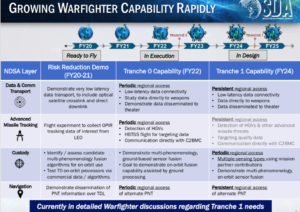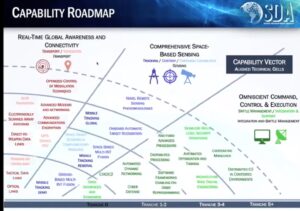 UPDATED To Include Link To Space Symposium 365 Video. WASHINGTON: The Space Development Agency (SDA) and the builder and operator of America’s spy satellites, the NRO, are discussing how to move imagery more rapidly from spy satellites to warfighters for targeting, SDA Director Derek Tournear tells me.
UPDATED To Include Link To Space Symposium 365 Video. WASHINGTON: The Space Development Agency (SDA) and the builder and operator of America’s spy satellites, the NRO, are discussing how to move imagery more rapidly from spy satellites to warfighters for targeting, SDA Director Derek Tournear tells me.
The two agencies are working on “joint roadmaps where we’re planning on being able to integrate their layer and get to the Transport Layer,” he says in an exclusive interview. SDA’s plan is to combine data from NRO imaging satellites with data gathered from commercial imaging providers to provide operators with near-real time ground target tracking and targeting information via what SDA calls the “Custody Layer” of its National Defense Space Architecture.
One option could be developing direct optical cross-links to connect NRO imaging satellites to SDA’s data Transport Layer constellation, Tournear said, noting that “it hasn’t been ruled out.” Another approach would be “a bent pipe” solution — downlinking NRO imagery to ground control centers, integrating it with imagery from commercial satellites, uploading that combined data to SDA’s Transport Layer, and then downlinking it to users.
SDA’s Transport Layer constellation, when completed, will comprise 300 to 500 satellites and form the “backbone” communications network that eventually all DoD command and control (C2) systems will link into, under a May order by former Defense Secretary Mark Esper meant to set up the Transport Layer as a key space node to enable Joint All-Domain Command and Control (JADC2).

SDA current plans
Tournear explained that the rationale behind the Custody Layer is the need for speed, and the ability to directly transfer targeting data to ground, sea and air-based weapon systems. That ability to connect all sensors to all shooters is one of the central concepts embedded in the JADC2 strategy nearing completion by the Joint Staff.
Given that NRO is a Title 50 (Intelligence Community) organization, its main customers are the National Security Agency (NSA) and the National Geospatial-Intelligence Agency (NGA), Tournear noted. “They are really trying to answer the Intelligence Community’s questions [about] the strategic planning the nation needs to be able to make decisions. That’s their mission. … And so they will collect a lot of data, including a lot from commercial as well as their own satellites.”
SDA, on the other hand, is a Title 10 organization (military), with a tactical mission trying to answer the question: “How do I get the actual fire control or targeting solution to a weapons platform?” he said.
“So, that means that NRO is going to focus on getting ‘the most’ — the most in quantity and the most in quality data, so that they can provide that to people to do analysis. SDA is more focused on timeliness, and how can we get data to a weapons platform as rapidly as possible,” Tournear said.
Noting that it would “not be in the country’s best interest” for SDA to duplicate what NRO is doing, Tournear said the Custody Layer therefore would not involve SDA building its own satellites. “What we are focused on in the Custody Layer is the ability to take those data that other people are providing and provide rapid pathway to a weapons platform,” he stressed.

SDA Capability Roadmap, February 2021
SDA also will be pursuing agreements with commercial imagery firms to use their satellite data. The “ideal” plan is to provide willing commercial vendors with optical cross-linked software, developed to SDA published standards, to carry on their satellites, Tournear said. No contracts with commercial vendors have yet been signed, he said, but SDA is undertaking some demonstrations using commercial imagery. (He declined to name partners in those demos.)
Charts published by SDA on its current plans show they plan to have a limited capability to provide beyond-line-of-sight targeting data to users in 2024, when the agency’s Tranche 1 constellation of some 150 satellites is up and running. However, Tournear demurred from characterizing what that meant regarding how many satellites would be integrated into the Custody Layer by then, or exactly how they’d be integrated.
“Whatever capabilities our mission partners have fielded, or the sensing modalities, we are going to enable that to get to the Transport Layer and be fused with other sensor data so that it can be sent to a weapons platform,” he said. “It’s a little nebulous, because all I can really commit to is to say whatever our mission partners fly with sensing, … we’ll get those data into a weapon.”
SDA is readying a request for proposals (RFP) to industry for Tranche 1 for release in August, Tournear told the Space Foundation’s Space Symposium 365 forum today (moderated by me.)
The agency currently is working to launch the first of its demonstration satellites, Tranche 0, by 2022. The idea is that every two years improved capabilities will be fielded, he explained, with SDA already having a good idea of what it wants to see through Tranche 2, for fielding in 2026, and some ideas for Tranche 3, for fielding in 2028.
SDA awarded Lockheed Martin and newcomer York Space Systems contracts to build 10 data relay satellites each for the Transport Layer’s Tranche 0, all of which are to be on orbit by 2023. Lockheed Martin’s contract is worth $187.5 million; York’s is worth $94 million.
In October, the agency awarded SpaceX $149 million and L3Harris $194 million to each build four satellites for the agency’s Tracking Layer Tranche 0. And the Missile Defense Agency awarded L3Harris and Northrop Grumman contracts to each develop a prototype satellite to carry the medium field of view Hypersonic and Ballistic Space Sensor (HBTSS) for the Tracking Layer. L3Harris’s contract worth $121 million was awarded on Jan. 14; and Northrop Grumman’s $155 million on Jan. 22. Those satellites also are all expected to be on orbit by 2023.
Major trends and takeaways from the Defense Department’s Unfunded Priority Lists
Mark Cancian and Chris Park of CSIS break down what is in this year’s unfunded priority lists and what they say about the state of the US military.


























